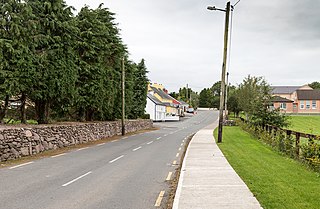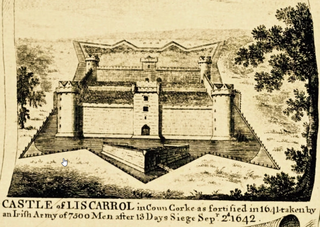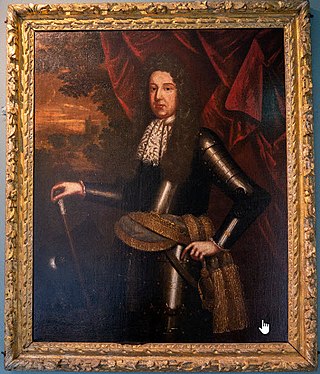Related Research Articles

The Kingdom of Desmond was a historic kingdom in southwestern Ireland. It was founded in 1118 by Tadhg Mac Cárthaigh, King of Munster when the Treaty of Glanmire formally divided the Kingdom of Munster into Desmond and Thomond. It comprised all of what is now County Cork and most of County Kerry. Desmond was ruled by the Mac Cárthaigh (MacCarthy) dynasty. Other clans within the kingdom included the O'Sullivans and O'Donovans. Following the Norman invasion of Ireland in the late 12th century, the eastern half of Desmond was conquered by the Anglo-Normans and became the Earldom of Desmond, ruled by the Fitzmaurices and FitzGeralds—the famous Irish family known as the Geraldines. The king of Desmond, Diarmaid Mac Cárthaigh submitted to Henry II of England, but the western half of Desmond lived on as a semi-independent Gaelic kingdom. It was often at war with the Anglo-Normans. Fínghin Mac Carthaigh's victory over the Anglo-Normans at the Battle of Callann (1261) helped preserve Desmond's independence. The kings of Desmond founded sites such as Blarney Castle, Ballycarbery Castle, Muckross Abbey and Kilcrea Friary. Following the Nine Years' War of the 1590s, Desmond became part of the Kingdom of Ireland.

Aghabullogue or Aghabulloge is a village and parish in the barony of Muskerry East in County Cork, Ireland. It lies around 30 km (19 mi) west of Cork City, south of the Boggeragh Mountains and north of the River Lee.

The Battle of Liscarroll was fought on 3 September 1642 in northern County Cork, Munster, between Irish Confederate and Royalist troops. The battle was part of the Irish Confederate Wars, which had started in the north in 1641 reaching Munster in 1642. The Confederates, about 8,500 strong, were led by Garret Barry, an Irish veteran from the Spanish Army of Flanders. The Royalist forces, about 2,400 strong, were commanded by Murrough O'Brien, 6th Baron of Inchiquin, an Irish Protestant. Despite his numerical disadvantage Inchiquin routed his enemies by the strength of his cavalry and the firepower of his musketeers.

Sir Donough MacCarty, 1st Earl of Clancarty (1594–1665), was an Irish soldier and politician. He succeeded his father as 2nd Viscount Muskerry in 1641. He rebelled against the government and joined the Irish Catholic Confederation, demanding religious freedom as a Catholic and defending the rights of the Gaelic nobility. Later, he supported the King against his Parliamentarian enemies during the Cromwellian conquest of Ireland.
Cormac Laidir MacCarthy, 9th Lord of Muskerry (1411–1494), was an Irish chieftain. He founded Kilcrea Friary and built Kilcrea Castle.
The post of Lord President of Munster was the most important office in the English government of the Irish province of Munster from its introduction in the Elizabethan era for a century, to 1672, a period including the Desmond Rebellions in Munster, the Nine Years' War, and the Irish Rebellion of 1641. The Lord President was subject to the Lord Deputy of Ireland, but had full authority within the province, extending to civil, criminal, and church legal matters, the imposition of martial law, official appointments, and command of military forces. Some appointments to military governor of Munster were not accompanied by the status of President. The width of his powers led to frequent clashes with the longer established courts, and in 1622 the President, Donogh O'Brien, 4th Earl of Thomond, was warned sharply not to "intermeddle" with cases which were properly the business of those courts. He was assisted by a Council whose members included the Chief Justice of Munster, another justice and the Attorney General for the Province. By 1620 his council was permanently based in Limerick.

The MacCarthy Reagh dynasty are a branch of the MacCarthy dynasty, Kings of Desmond, deriving from the Eóganacht Chaisil sept.

Justin McCarthy, 1st Viscount Mountcashel, PC (Ire), was a Jacobite general in the Williamite War in Ireland and a personal friend of James II. He commanded Irish Army troops during the conflict, enjoying initial success when he seized Bandon in County Cork in 1689. However, he was defeated and captured at the Battle of Newtownbutler later in the same year. He escaped and was accused of having broken parole. After the end of the war, he led an Irish Brigade overseas for service in the French Army. He died in French exile.

General Sir Webb Gillman, was a British Army general during the First World War.

Teige-an-Duna MacCarthy, Lord of Glean-na-Chroim, was the last hereditary Prince of the Dunmanway branch of the MacCarthy Reagh dynasty of Carbery "who exercised the rights of his position." He was Prince from 1618 to 1648, dying the following year on 24 May 1649. He was also known as Teige the Hospicious for his great hospitality, while his epithet an Duna means "of the Fortress".

The MacCarthy dynasty of Muskerry is a tacksman branch of the MacCarthy Mor dynasty, the Kings of Desmond.

Carrignamuck Tower House, located in Carrignamuck townland, is a 15th century tower house located 2.8 km (1.7 mi) north of Coachford village and 2 km (1.2 mi) north-west of Dripsey village. It is also sometimes known as 'Dripsey Castle', a name latterly attributed to the 18th century house, Dripsey Castle, built nearby.

Carrignamuck is a townland within the civil parish of Magourney and catholic parish of Aghabullogue, County Cork, Ireland. It is 363.76 acres in size, situate north-east of Coachford village, and north-west of Dripsey village.
Clontead More House is a country house in the townland of Clontead More, situated 2.3 km (1.4 mi) north-east of Coachford village. Building c. 1840, it is one of a number of such estate houses situated along the valley of the River Lee and its tributaries.

Castlefreke, also known as Rathbarry, is a townland and village in County Cork, Ireland. The townland is located in the civil parish of Rathbarry on the R598 regional road, to the east of Rosscarbery.
Maurice Roche, 8th Viscount Fermoy (1597–1670) was an magnate and soldier in southern Ireland, and a politician of the Irish Catholic Confederation. He joined the rebels in the Irish Rebellion of 1641 in January 1642, early for Munster, by besieging Richard Boyle, 1st Earl of Cork, a Protestant, in Youghal. He fought for the Confederates in the Irish Confederate Wars and sat on three of their Supreme Councils. He fought against the Parliamentarians in the Cromwellian conquest of Ireland and was excluded from pardon at the surrender in 1652. At the restoration of the monarchy in 1660 he recovered his title but not his lands.

Cormac MacDermot MacCarthy, 16th Lord of Muskerry (1552–1616) was an Irish magnate and soldier. He fought at the Siege of Kinsale during Tyrone's Rebellion.
Dermot MacCarthy (1310–1367) was the 1st Lord of Muskerry. He was an Irish magnate who owned extensive lands in central Munster. He was the first of the long line of the MacCarthy of Muskerry dynasty.

Cormac Oge Laidir MacCarthy, 10th Lord of Muskerry (1447–1536) was an Irish chieftain, styled Lord of Muskerry. In 1520 he defeated James FitzGerald, 10th Earl of Desmond in the battle of Mourne Abbey.

Castlehyde is a townland and estate, slightly west of Fermoy in County Cork, Ireland. The estate's manor house, Castlehyde House, had been the ancestral home of Douglas Hyde's family and is one of several houses owned by Irish dancer, Michael Flatley.
References
- 1 2 Burke, Bernard; Fox-Davies, Arthur Charles (1912). A genealogical and heraldic history of the landed gentry of Ireland. Dalcassian Publishing Company. p. 267.
- ↑ "Lot 112: 22ct mathematical gold medal, 1853". The Cotswold Auction Company. 2 October 2012. Retrieved 4 November 2020.
- ↑ Taswell-Langmead, Thomas Pitt; Carmichael, Charles Henry Edward; Eversley, William Pinder; Baker, Sir Sherston (1866). The Law Magazine and Review: A Quarterly Review of Jurisprudence, Volumes 21-22. Saunders and Benning. p. 361.
- ↑ Digby, William (1879). Forty Years of Official and Unofficial Life in an Oriental Crown Colony: Being the Life of Sir Richard F. Morgan, Kt., Queen's Advocate and Acting Chief Justice of Ceylon, Volume 2. Higginbotham. p. 86.
- 1 2 Gillman, Alexander William (1895). Searches into the history of the Gillman or Gilman family : including the various branches in England, Ireland, America and Belgium. London: Elliot Stock. pp. 89–92.
- ↑ "Clontead More House". Landed Estates Database. National University of Ireland Galway. Retrieved 4 November 2020.
- ↑ "CO-MORY-0075". HistoricGraves.com. Retrieved 4 November 2020.
- ↑ "Obituary - Herbert Webb Gillman, BA, JP, BL, FRSA" (PDF). Journal of the Cork Historical and Archaeological Society. IV. Cork Historical and Archaeological Society: 241–242. 1898.
- ↑ "CO-MORY-0076". HistoricGraves.com. Retrieved 4 November 2020.